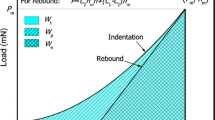Abstract
Cyclic indentation was used to evaluate the dynamic deformation of aluminum. Under the load-controlled cyclic indentation, the indenter continuously penetrated into the material and reached a steady state at which the penetration speed (per cycle) was a constant. The amplitude of the cyclic indentation depth was basically controlled by the amplitude of the cyclic indentation load, independent of the mean indentation load and the indentation frequency. The steady state penetration speed decreased with increasing the amplitude of the cyclic indentation load due to the increase in the size of plastic zone. It also decreased with the increase in the mean indentation load due to local strain hardening, while it increased with the increase of the indentation frequency.













Similar content being viewed by others
References
Klesnil M, Lukas P (1980) Fatigue of metallic materials. Amsterdam, The Netherlands7 Elsevier Science
Sarfarazi M, Ghosh K (1987) Eng Fract Mech 27:257
Samuels LE (1986) In: Blau PJ, Lawn BR (eds) Microindentation techniques in materials science and engineering, ASTM STP 889. Am. Soc. Testing and Mater., Philadelphia, pp 5–25
Yang FQ, Jiang CB, Du WW, Zhang ZQ, Li SX, Mao SX (2005) Nanotechnology 16:1073
Vaughan DAJ, Guiu F (1887) Brit Ceram Proc 39:101
Reece M, Guiu F (1991) J Am Ceram Soc 74:148
Takakura E, Horibe S (1992) J Mater Sci 27:6151
Guillou M-O, Henshall JL, Hooper RM (1993) J Am Ceram Soc 76:1832
Henshall JL, Guillou M-O, Hooper RM (1996) Fatigue Fract Eng Mater Struct 19:903
Guiberteau F, Padture NP, Cai H, Lawn BR (1993) Phil Mag A 68:1003
Cai H, Kalceff MAS, Hooks BM, Lawn BR, Chyung K (1994) J Mater Res 9:2654
Padture NP, Lawn BR (1995) J Am Ceram Soc 78:1431
Kim DK, Jung Y-G, Peterson 1M, Lawn BR (1999) Acta Mater 42:4711
Ann L (1999) J Am Ceram Soc 82:178
Li JCM, Chu SNG (1979) Scripta Metall 13:1021
Chu SNG, Li JCM (1980) J Eng Mater Tech Trans ASME 102:337
Loubet JL, Georges JM, Meille G (1986) In: Blau PJ, Lawn BR (eds) Vickers indentation curves of elastoplastic materials, ASTM STP 889. Am. Soc. Testing and Mater., Philadelphia, pp 72–89
Sneddon IN (1992) Quart J Mech Appl Math 45:607
Suresh S (1998) Fatigue of materials, 2nd edn. Cambridge University Press
Cheng YT, Cheng CM (2004) Mater Sci Eng R44:91
Yang FQ, Peng LL, Okazaki K (2004) Metal Mater Trans A 35:3323
Hill R (1950) The mathematical theory of plasticity. Clarendon Press, Oxford
Johnson KL (1970) J Mech Phys Solids 18:115
Yang FQ, Peng LL, Okazaki K (2004) J Mater Res 19:1243
Acknowledgments
This research is supported by NSF through a grant CMS-0508989 and Kentucky Science and Engineering Foundation through a grant KSEF-148-502-03-73.
Author information
Authors and Affiliations
Corresponding author
Rights and permissions
About this article
Cite this article
Yang, F., Peng, L. & Okazaki, K. Cyclic indentation in aluminum. J Mater Sci 42, 4513–4520 (2007). https://doi.org/10.1007/s10853-006-0480-2
Received:
Accepted:
Published:
Issue Date:
DOI: https://doi.org/10.1007/s10853-006-0480-2




